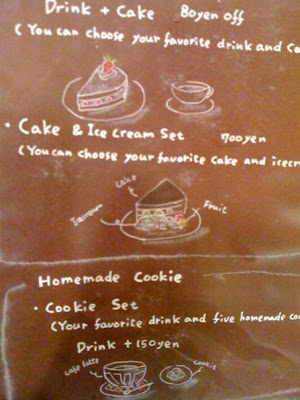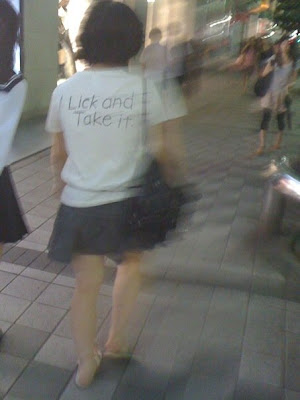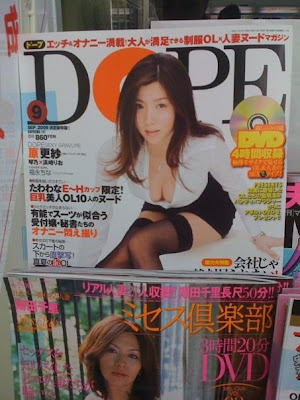Sunday, August 30, 2009
Tubing
Our New Mini Cooper Bikes


Nagoya is one city that is easy to get around because of the numerous means of transportation available. Since we got here we have utilized trains, subways, taxis and good old fashioned walking to get around. But this week we added another method of transport to our list: bikes. Awesome folding mini-cooper bikes that is. Now for the most part, bikes in Japan are pricier than the States, so we've been shopping around quite a bit in order to get the best deal. We ended up paying a bit more than we originally planned for these beauties, but they were well worth it. They are foldable, and much lighter and smaller than other folding bikes we came across. We also opted for these because they have Shimano brakes, as well as gears. Once we picked out the bikes (dark green for Marlow, and burgundy for me) we set out to accessorize with locks, lights and a basket before we sealed the deal. In the States, after you fork over the cash, you can walk (or ride) straight out the door, but in Japan you must first register your bike before you leave. If you bike ever gets lost or stolen, it doesn't necessarily fall off the face of the planet, never to be seen or heard from again. In Japan, stolen bikes are a big deal, and if you are caught with one you can land in some trouble with the law. Anyway, here is a video Marlow made of our new bikes:
Friday, August 28, 2009
Rumble in Aichi: Sumo Comes to Town
Marlow and I went to our first sumo tournament in Nagoya, and we had a great time! We ended up with nosebleed seats, but that really didn’t affect our experience, we still really enjoyed it. To fill you in, here is a crash course in sumo: there are nine ranks of sumo wrestlers, the top four being the upper ranks including the highest, yokuzuna. We arrived in time to see the pros as they were introduced and paraded around the ring wearing fancy, bright aprons (I read some of these aprons can cost up to $5,000 as they often feature silk and gold embroidery! $5,000?! Believe it). We also spotted a few foreign wrestlers--they were pretty easy to recognize from our distant seats as they were much hairier than the Japanese wrestlers. Here is a breakdown of interesting sumo facts:
*Sumo, though it has evolved a little, is over 1500 years old, and began as part of a ceremony to the gods to pray for plentiful crops.
*The hairdo of today’s higher ranking wrestlers is consistent with those of early sumo wrestlers, and (according to the official sumo website…I’m not making this up) can also help to protect the wrestler’s head in the event of a fall.
*The title of yokozuna has been around for 300 years, yet only 62 wrestlers have ever coveted the position.
*Unlike American boxing, there are no weight limits or ranking systems, so wrestlers can be faced with opponents much heavier than themselves.
*The gyoji or referees are the guys who look like they are wearing fancy pajamas and running around the wrestlers. Their pajamas are actually a type of kimono, and they too are part of a ranking system: the lower ranking gyogi are barefoot and the higher have cool Teenage Ninja Turtlesqe split toe socks.
*Before the wrestlers actually collide, there is a period of pumping themselves up, glaring at their opponents and throwing salt. This part of the match is called the shiriki, and it allows the wrestlers to build up excitement among spectators, but what’s most interesting is the 4 minute time limit that has been implemented recently. The first time limit was implemented in 1928, and it was 10 minutes! I guess ADD has affected even the most devoted of sumo fans. The actual wrestling time within each match is often less than a minute or two long.
Thursday, August 27, 2009
Clamming
Over summer vacation Marlow and I, along with our friends Ken and Miggy went to our buddy Clayton's place in Hammamatsu. Clayton invited us to go digging for clams, pretty much in his backyard. We all had a great time, and scored a ton of clams (which were absolutely delicious by the way)--we'll most definitely make the trip back for some more clams again! Here is a short video I put together of our day:
Friday, August 21, 2009
Good Ramen: Ijinkan




Before I came to Japan, I was tricked into thinking those 20 for $1 packets of dried instant ramen noodles were real ramen--I didn't know any better. Besides, in America ramen isn't part of the international food craze, like pizza or sushi. Americans don't often say "Oh man, I know this great little ramen place..." nope, ramen is something that has remained on the bottom shelves of grocery stores nationwide known only as a cheap meal, and has never really found its way into our hearts. Bottom line: Americans don't take ramen seriously. Well, the Japanese do. I have yet to find a main street, or busy shopping area without a ramen restaurant. As a matter of fact, I currently live within a 5-10 minute walk of 2 ramen shops right now. Though ramen is a Chinese food, the Japanese have developed quite a liking to it, and have adopted it as their own, only of course, after tweaking it slightly. For the record, there are a few different types of ramen: salt, pork bone, and soy sauce being among the most popular. Most Chinese restaurants I've been to serve the clear-broth salt version as a standard, while many ramen shops in Japan give you a few different styles to choose from, most of which seem to be of the cloudier pork bone variety. As it happens, I absolutely love the popular Japanese pork-bone ramen. I've tried ramen in countless restaurants, more times than I care to say, and I haven't been disappointed once. For the most part I think its safe to say that all ramen is really good here. But there is one place that I've found to reign supreme: Ijinkan. The broth is the best I've come by so far: just the right amount of cloudiness and salt combined with the small ringlets of fat floating under and around a heap of beansprouts, bamboo shoots and onion is heavenly. Ijinkan, like many ramen shops in Japan has bar-style seating in which customers just sit and eat at a counter. Ramen shops often seem to radiate a fast-food type atmosphere, though not quite like McDonald's, you can often get in and out in under 30 minutes or less depending on how fast you can slurp those noodles (yes, slurping your noodles is THE way to eat ramen in Japan). Ijinkan is no exception: cheap, quick food that tastes great. Once you enter, you can choose a seat at the counter, or opt for their extra seating in the back of the restaurant. Water is brought automatically, and you can help yourself from pitchers located on the counters and tables (also a common in many ramen shops). After choosing your type of ramen, usually consisting of different toppings as well as broths, you can raise your hand and say "Sumimasen!" ("Excuse me!") or press the bell to get their attention. Yes, I said bell. In many restaurants in Japan, you can often find a bell with which to call a server located right on your table. It usually makes a cute little doorbell sound when you press it too. Ijinken has multiple locations, one of which is in Sakae, downtown Nagoya, at the south end of the LaChic building.
Good Cafe: Comohouse Cafe





On my birthday my husband surprised me by taking me to the most adorable little "Mom & Pop" cafe you can imagine. Living in the era of Starbucks and its rigid uniformity, it is refreshing to step into a privately owned cafe where everything is so different. Don't get me wrong, I need my Starbucks-short-chai tea latte-hot-with soymilk fix from time to time, and I appreciate the convenience and comfort through familiarity that Starbucks offers. But its the same pros of Starbucks that simultaneously make me yearn for something new. Nestled in a dim, sparsely populated shopping arcade just West of Nagoya Station, Comohouse Cafe is a real find. And by "real find" I mean it's a great place, but you must also try to find it as it is not located in a convenient, or even high-traffic location. But once you do, I'm pretty sure you'll whip out your iPhone almost instantly, to pinpoint your location so you can find it again. Before stepping in, you are greeted outside by a small table draped with a burgundy and white checkered tablecloth and whitewash wooden chairs, a good place to sit and have lunch while bringing your pet. The warm yellow lighting inside beckons you to enter, and as you swing open the wooden door you are greeted by soft music playing overhead. A not too high-pitched "Irasshaimase!" ("Welcome!") follows, and you know you've made a good decision. But it isn't until you find a seat among the few wooden tables situated near the door that you begin to notice all of the attention to detail surrounding you. The steaming hot towels carefully rolled, placed in wicker baskets and presented alongside sweating glasses of water are not of the pre-packaged variety, and small glass vases of various sizes, each with a different sprig of wildflowers adorn every table. And if it hasn't already, the novelty and sheer cuteness of this particular cafe will slap you in the face once you open the menu. Each dark brown page is carefully handwritten in white pencil and accompanied by small drawings of select menu items. But the careful preparation doesn't stop with the decor, the food is also given a lot of attention. Though the menu items may seem simple, the careful hand with which they are prepared makes all the difference. A wide variety of treats and dishes are available, from teas, coffees and cake, to sandwiches, soup and salad, all of which are inexpensively priced and offer satisfying portions. And their homemade cake selection for the day is available for immediate salivation over, in a cooler near the entrance. An English menu is also available, and will most likely just be brought to you automatically if you don't appear to be Japanese, as one of the owners speaks English and will be happy to accommodate you. Comohouse Cafe is located at 2-16-12 Nagono, Nishi-ku, Nagoya; Kokusai Center Station exit 1, walk straight for about 7 minutes until you reach the shopping arcade, and turn left. Open until 7:30 weekdays, 7:00 Sundays and closed Tuesdays. 052-541-1271
Tuesday, August 18, 2009
Theftless in Nagoya

In the middle of Sakae, downtown Nagoya, some chicks left all of their stuff--and I mean all of it. Shopping bags, and even purses were set in the middle of the sidewalk on a Friday night, in one of the largest cities in Japan...and no one laid a finger on anything. Even stranger, no one even looked at it like it was strange. I actually stood on this for a few minutes to test my theory and feed my curiosity---I was sure that if no one tried to take anything, someone would at least think this was strange. Nope. No one glanced at the pile of belongings longer than the time it took to realize they had to walk around it. It would seem as though there is a better chance of having things taken from you in the States when you are actually in possession of them, than there is of someone taking your carelessly strewn and unattended belongings on the street in Japan. Japan, 1, USA 0.
I Lick It and Take It




Many things in Japan make me chuckle, giggle, and occasionally explode with laughter, but few things are as amusing to me as the T-shirts here. Specifically, I am talking about the Engrish on shirts that tickle me to no end. For the most part, the best (and by "best" I stress that I mean, funniest and strangest) are usually still hanging on clothing racks--although there are many people wearing shirts with wacky messages, usually the better ones are still in stores. But walking in Sakae the other night I managed to get a pic of this girl wearing a shirt that read "I Lick it and Take it". I literally ran across the street in an attempt to catch up with her, all the while juggling my many bags and groping around in my purse in a desperate attempt to find my camera...and here you have it.
Cool Melons

This is the second time this summer I have seen watermelons kept cool via natural resources. The first was by a co-worker and her Filipino family on the beach as they buried their watermelon deep beneath the sand under an umbrella. This is the second, two melons placed near these rocks by the shore. The cool water lapping over them throughout the course of the day kept them cool indeed (yes, I touched the melons). Good idea.
Dope Magazine

While waiting to use the bathroom at a convenience store this past week, I glance over to the magazine section, strategically placed in the darkest corner of the shop. As most convenience stores in Japan offer a wide variety of adult reading material, complete with tell-tale photos of scantily clad, busty women, they are usually housed in the corners of most stores as to lure the creepy dudes who gather around the glossy pages to a position where they are out of the way. So, waiting for the bathroom placed me right in front of the adult magazines at this particular shop, and this copy of Dope Magazine caught my attention and gave me a chuckle.
Friday, August 7, 2009
Stepping Over the Yellow Line

I've seen my share of strange, funny, crazy and downright confusing advertisements since I've been in Japan. And yes, I've often gotten a cheap kick out of ads here because of goofy things like grammatical or spelling errors (AKA to foreigners, Engrish) or just nonsensical stuff. But this is actually one of my favorite ads, and that's quite possibly because I can't laugh at it--it's all in Japanese, so I can't read most of it. It's a safety ad reminding people to be aware, and careful not to step over the painted yellow line that runs within inches of the train tracks. The use of Legos alone is just so charming, but combined with the business man who loses his footing while looking at the passing flock of freshly-dismissed schoolgirls is just hilarious...and kinda creepy in a way.
Thursday, August 6, 2009
Sumo Wrestler in Nagoya Station
Nihon Fried Chicken

For the most part the Japanese like American food, at least once in a while (Japanese people are all pretty thin, so they can't be eating it too often). But one of the reasons foreign food is popular is Japan is that it is often made "Japanese Style" to accommodate the highly sensitive Japanese tastebud. Japanese food is predominantly simple in taste with usually few ingredients, and this style of cooking is often imposed onto foreign recipes. But not American fast food. McDonald's (pronounced mac-a-dun-al-do) and KFC have managed to stay true to their original recipes in Japan. But in this case, the Colonel wasn't able to hang on to his American fashion sense....meh, you win some, you lose some.
Fail in the Gap

Among my very first experiences in Japan was shopping. The fashion is really great here, and there are countless (and I mean that quite literally) of women's clothing shops. I remember finding the Gap for the first time, and feeling somewhat relieved as one naturally would after finding something familiar in a place where so many things seem alien. But that familiarity would be short-lived. I waltzed in, found some things to try on and shuffled off to the dressing room. The attendant, a very nice and pretty young girl, showed me to my room. But before she drew the curtain, she handed me a neatly folded square of tissue-paper and said something (I presume was an explanation) in Japanese I couldn't understand. Now, at the time I hadn't the slightest idea what this paper was for. Behind the curtain, I held the square in my hand and stared at it for a while, trying to figure out what its purpose was. Don't ask my why, because I don't have a problem myself in that area, but the first thing I thought it could be was a towel for armpit-sweat. Or maybe foot sweat? Oh jeeze, I have no idea. But I did know one thing, when I came out of that little room, the attendant would expect that I used the paper for whatever its used for. So after trying on the clothes, I stuffed the mystery paper into my bag, and sped off hoping the attendant wouldn't ask for the paper back, or come to notice I'm not smart enough to figure out how to use it. A few weeks after that, though slightly jaded, I ventured off into the dressing room of a small Japanese clothing shop. And, as I feared, I was handed the dreaded square of tissue paper again. Deja-vu. Here I am again behind the curtain, bewildered. I looked up, and there they were: directions (with pictures) on how to use the tissue paper. Turns out it is a face cover for women to wear while they try on clothing to prevent makeup from smearing on prospective garments. It really is a very sensible idea, as I can't count how many times I have seen rejected shirts in the States on sale because of makeup smears all over the collar. Japan: land of common sense. Props.
$1,000 Fan!

I don't know what this thing is made of, but it sure doesn't look like it's worth such a giant hunk of anyone's hard-earned money. I'm sure it's handcrafted from the finest wood in the world, blah, blah, blah, but it is still shocking to me nonetheless. It doesn't even look that fancy. Of course I realize that expensive doesn't always mean fancy per say, but if I'm going to spend a grand on something that can fit in my pocket, it better be good. Perhaps my inner American shines through the most at a time like this--were I to be asked to imagine what a $1,000 fan would look like, this wouldn't even come close--precious metals and jewels come to mind almost immediately. Personally, I don't buy fans that cost over 100 yen--and now that I think about it, I could have sworn I've seen a fan that looks a lot like this for 100 yen...and even if it didn't, who cares? You are just going to be whipping it around and fanning yourself anyway, most people won't even get a chance to notice the "fine craftsmanship", and those that try risk getting whiplash. Nope, if I ever pay this much money for a fan, I'll get one with a TV in it.



